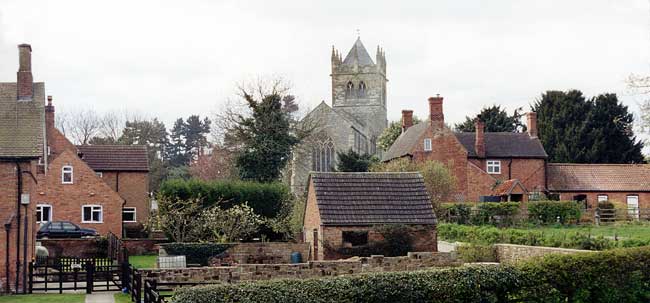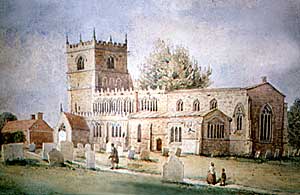St. Michaels, Laxton.
BY HARRY GILL, F.S.ARCH.
Read at the Society's Visit, June 4th, 1924.

St Michael's church, Laxton (photo: A Nicholson, 1998)
IN the Middle Ages this parish church was one of the largest and finest in the county.
From the 12th century onwards, a succession of noble patrons—the Everinghams, Lexingtons, and their posterity—enriched it with their prestige and wealth.
When we recall that Henry, one of the three distinguished sons of Richard de Lexington, was Dean and afterwards Bishop of Lincoln1 during the erection of the world famous Angel-choir there, (1255-1280) we are not surprised to find a reflection of that glorious conception here; and when we further remember that this church is dedicated to St. Michael the Archangel and all Angels, we cease to wonder at the host of angelic figures on tombs and stone furniture and roof which once adorned it.
But alas ! we now see but the indications of former stateliness. When Throsby wrote his history (1797) he could find no language strong enough to express his indignation at the desolation which he saw.
Sir Stephen Glynne, whose MS. notes I have been enabled to consult by the courtesy of our late Hon. Secretary, Mr. George Fellows, visited the church in 1854 and wrote "a fine church, full of interesting features . . the interior fine and solemn . . but unhappily in a state of neglect and decay."

Laxton church before the restoration of 1861.
In 1861 work of renovation was commenced under the direction of Mr. T. C. Hine of Nottingham. It can scarcely be termed a "restoration" for the tower2 was pulled down; the proportions of the nave were sadly injured by the abstraction of one of its bays; the north porch was demolished; the south porch and the outer walls of the aisles, where they had gone out of upright, were also pulled down. New outer walls were built in order to reduce the aisles in width and so bring the area of the church more into conformity with the size of the village.
The tower was rebuilt with old materials and capped with a pyramidal roof of slates. The chancel and aisles were also covered with slates in coloured bands; and this in a rural village where red tile roofs predominate! Sufficient of the old work is left, however, to enable us to trace the history of the church without leaning too much upon conjecture. The earliest record of a church here is found in the statement that a Norman lord of the manor, Ralph Hauselin (Alselin) and his relative, Robert Caux, founded a Priory for Austin Canons at Shelford in the reign of Henry II (1154-1189) to which they gave Laxton Church as part of the endowment. As the first Prior of Shelford was instituted in 1204, it is a fair assumption that Laxton Church also was in existence by that time, at any rate.
We may see remnants of that early fabric when we look towards the west end, for the truncated arcades of the old nave still stand "bold and grand" with obtuse pointed arches carried on tall cylindrical piers which stand above circular stone platforms. The base mouldings are of the "water-holding" type, and the capitals consist of a deeply undercut circular abacus, plain bell and narrow necking bead, all out of one stone; the tower arch is slightly earlier in character but it appears to be the ancient stonework re-set: the bowl of the font is perhaps contemporary although now set on a stem made up with a patchwork of fragments of cluster shafts.
Ignoring the clerestorey and roof for the moment we may say that the old nave was Transitional work, i.e., between Norman and Early English date c. 1190.
We know that the advowson reverted to the Lords of this manor during the 13th century (probably in exchange for Gotham) for in the list of Vicars and patrons the name of the prior and convent of Shelford gave place to Rich: de Lexington, who presented to the Vicarage in 1240.
With the church in local keeping once more, a period of great splendour set in. A chantry altar dedicated to the Blessed Virgin (one of the first chantries to be instituted within a parish church) was endowed by Sir John de Lexington in the mother church of Laxton, where the bodies of his mother and sisters lie at rest, and where Divine Service was to be celebrated daily and nightly for his soul, the soul of Margery his wife, Richard his father, and Maud his mother, and Henry III his King, and others. This chantry was vested in the prior of Rufford.
This altar was in the "North cemetery" as Torre calls it:—the place of sepulchre for the inferior lords, the Lexingtons, as the south cemetery was for the superior lords, the Everinghams. The chantry deed is undated, but it lay between the years 1250-1260. The institution of this chantry necessitated the rebuilding of the chancel and aisles.
Not content with a chantry in monastic keeping, Robert Lexington shortly afterwards founded and endowed the chantry of St. Edmund. This was a donative, and seeing that no traces of a chapel of St. Edmund have been found, the priest probably celebrated at St. Mary's altar. According to a map of the manor dated 1632, a chantry house to accommodate two priests stood a little to the eastward of the church and several "portions" in Laxton fields were set aside for the support of two chantry priests.
After a time, the Lexingtons removed their residence to Tuxford manor, and thereafter Tuxford Church became their place of sepulchre where two other chantries were endowed by their successors the Longvilliers in 1334 and 1357 respectively.
(1). Buried at Lincoln near Grossetete, but no trace of his grave remains.
(2). The signatures of two men engaged in raising the tower appear on a document dated "the Feast of St. Lawrence 12 Edward III" (1339).
